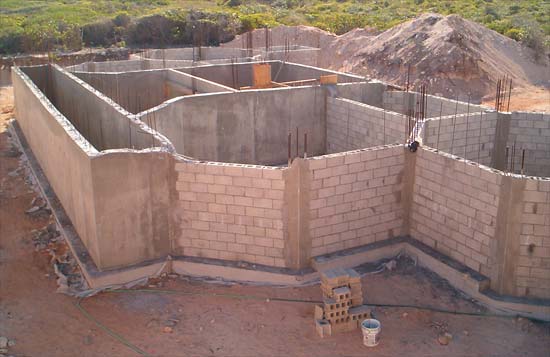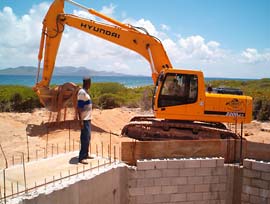- WELCOME
-
SLEEP
-
REALTY & BUSINESS
-
THINGS TO DO
-
EAT
- SPECIAL
- KEEP IN TOUCH
- SAVE 10%
|
|
All the foundation walls are up...

One important decision for Anguilla homes near the seashore is how high to raise the foundation walls. They start at the footings, which are at rock level, but how high do you raise them? Several factors impact on this decision...
Required view is one factor, the higher you are the better the view.
Location is another factor. A home that is one hundred feet from the water's edge would require a higher elevation to humbly attempt offsetting some of Mother Nature's forces.
Topography and ambient soil conditions are also to be considered. You generally do not want to build on the lowest spot of your land. You must allow for proper drainage of water away from around your house, no matter how it gets there, whether it be heavy rains of a tropical storm or ocean surges of a hurricane.
Soil conditions should also be inspected to determine if water will readily drain away from your Anguilla home. A soil that reaches its saturation level quickly is a factor that needs serious consideration.
Having done that homework, we made a final decision to place our first floor slab 36 inches above the surrounding level of the land. This elevation will not appear when we do the final grading of the earth around and away from the house.
When erecting the foundation walls, we stop them just below where the slab will come to rest on them. In other words, if your main slab will sit 36 inches above ground elevation, you stop building the foundation walls at 36 inches minus the slab thickness. The final elevation is achieved with plywood forming and the thickness of the concrete slab itself.
A picture is worth one thousand words and I think that it really applies here so here is a shot that explains it...
Toby Inspecting Level

Another factor that impacts the foundation wall height is whether there will be a basement. We prudently decided not to have a basement due to the fact that we are very close to the shoreline. The only basement area that we have under the house is a small 7x10 foot area that will house noisy mechanical equipment we may need to install.
The backfilling begins. We store all the earth and sand from our initial excavation around the house and on the lot behind (with permission from the owner). So we were able to backfill without trucking. Trucking the earth away for storage and then back again is expensive. (This is an issue to be budgeted for if all surrounding lots are all inhabited.)
The backfilling process is not as easy as it looks. There are a few things to keep in mind...
An excavator is a big piece of equipment. The newly erected walls can obstruct the operator's view. You want to avoid damage to the foundation walls, either through hitting it with this heavy equipment or by backfilling in a manner that exerts too much unnecessary lateral force on the foundation walls. So you should have a lookout man helping the operator maneuver around the site and helping with backfill placement.
| Curtis Is The Lookout | |

|

|
Another consideration... if you have larger rocks/boulders in your backfill, make sure that they are not placed against and do not roll close to the walls. Damage through rolling boulders or point loads on the foundation wall should be avoided at all costs.
The operator of the excavator uses the back part of his shovel to compress the backfill as he places it. Wetting down and using a compactor on the backfill yields optimal results.
Calvin Watering The Backfill

Calvin Compacting, Toby Leveling With Shovel

Next Step? Now that we have finished the backfilling process, we're ready for the next step. It is time to call our master Anguilla plumber, Mr. Vanterpool (AKA "Sinatra" for his blue eyes). He will install all the drain pipes that the our future Anguilla home will require to move brown, grey and rain water.
Contact Mike & TurnKey Construction to build your tropical home

Tranquility Beach
(Luxury Hotel & Residences)

Long Bay Villas:
The Ultra-Luxury Villas
Sky, Sea & Sand

Santosha Villa Estate:
Anguilla's Most Sophisticated
Ultra-Luxury Villa
Facebook Comments
Have your say about what you just read! Leave a comment in the box below.